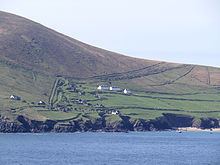Location Atlantic Ocean Highest point An Cró Mór Population 0 (2011) Area 4.29 km² Archipelago Blasket Islands | Highest elevation 292 m (958 ft) County Kerry Elevation 292 m Province Munster | |
 | ||
Major islands Great Blasket Island, Beginish, Inishnabro, Inishvickillane, Inishtooskert, Tearaght Island Similar Gallarus Oratory, Dingle Peninsula, Kilmalkedar Church, Eask Tower, Slea Head Drive | ||
Great blasket island experience with the peig sayers boat
Great Blasket (An Blascaod Mór in Irish) is the principal island of the Blaskets, County Kerry, Ireland.
Contents
- Great blasket island experience with the peig sayers boat
- Map of Great Blasket Island Co Kerry Ireland
- The dingle peninsula slieve mish to great blasket island
- GeographyEdit
- HistoryEdit
- DemographicsEdit
- LiteratureEdit
- Island WildlifeEdit
- AccommodationEdit
- Ownership disputeEdit
- References
Map of Great Blasket Island, Co. Kerry, Ireland
The dingle peninsula slieve mish to great blasket island
GeographyEdit
The island lies approximately 2 km from the mainland at Dunmore Head, and extends 6 km to the southwest, rising to 292 metres at its highest point (An Cró Mór). The nearest mainland town is Dunquin; a ferry to the island operates from a nearby pier during summer months. Despite its close proximity to the mainland, visitors to the Dingle coast can often not see the island through the notorious sea mist.
The most easterly extremity of the island, Garraun Point at 52.1045°N 10.5074°W / 52.1045; -10.5074 has been incorrectly cited as being the most westerly point of the Irish mainland.
HistoryEdit
The island was inhabited until 1953, when the Irish government decided that it could no longer guarantee the safety of the remaining population. It was the home of three noted Irish writers: Tomás Ó Criomhthain, Peig Sayers and Muiris Ó Súilleabháin. Their works were all written in Irish, and have all been translated into English, as well as other languages. The homes of Tomás Ó Criomhthain and Muiris Ó Súilleabháin are now in ruins but the house in which Sayers once lived has been restored, and used to form part of the hostel which previously functioned on the island.
Until 1953, the inhabitants of Great Blasket Island formed the most westerly settlement in Ireland. The small fishing community (even at its peak the population was hardly more than 150) mostly lived in primitive cottages perched on the relatively sheltered north-east shore. In April 1947, having been cut off from the mainland for weeks due to bad weather, the islanders sent a telegram to the Taoiseach, Éamon de Valera, urgently requesting supplies which duly arrived two days later by boat.
DemographicsEdit
The table below reports data on Great Blasket's population taken from Discover the Islands of Ireland (Alex Ritsema, Collins Press, 1999) and the Census of Ireland.
LiteratureEdit
Considering the tiny population, the island has produced a remarkable number of gifted writers who brought vividly to life their harsh existence and who kept alive old Irish folk tales of the land. Best known are Machnamh Seanamhná (An Old Woman's Reflections, Peig Sayers, 1939), Fiche Bliain Ag Fás (Twenty Years A-Growing, Muiris Ó Súilleabháin, 1933), and An tOileánach (The Islandman, Tomás Ó Criomhthain, 1929).
Island WildlifeEdit
The island has an abundance of walks on both a green road and mountain tracks. There is attractive flora and fauna, pre-historic remains, abundant sea-life and extensive bird life
AccommodationEdit
There is self-catering accommodation available in five restored houses at the top of the village on the Great Blasket Island. Accommodation consists of simple self-catering facilities including basic amenities with dorms to suit individual’s/ groups and private double rooms also available for couples sharing.
Ownership disputeEdit
The hostel and cafe that once operated on the island have been closed as a result of a dispute between the Irish State which wishes to make the island a national park and an individual who claims to own the greater part of the island. The differences between the State and Blascaoid Mor Teoranta (BMT) were settled by an agreement made in August 2007; subject to the granting of planning permission, the deal meant that more than 95% of the island land, including the old village, would be sold to the State and become a de facto national park. In 2009 the Office of Public Works bought most of the property on the island, including the deserted village, and the state is now the majority landowner. Guided tours of the island were launched in 2010 and plans are underway for the preservation and conservation of the old village.
